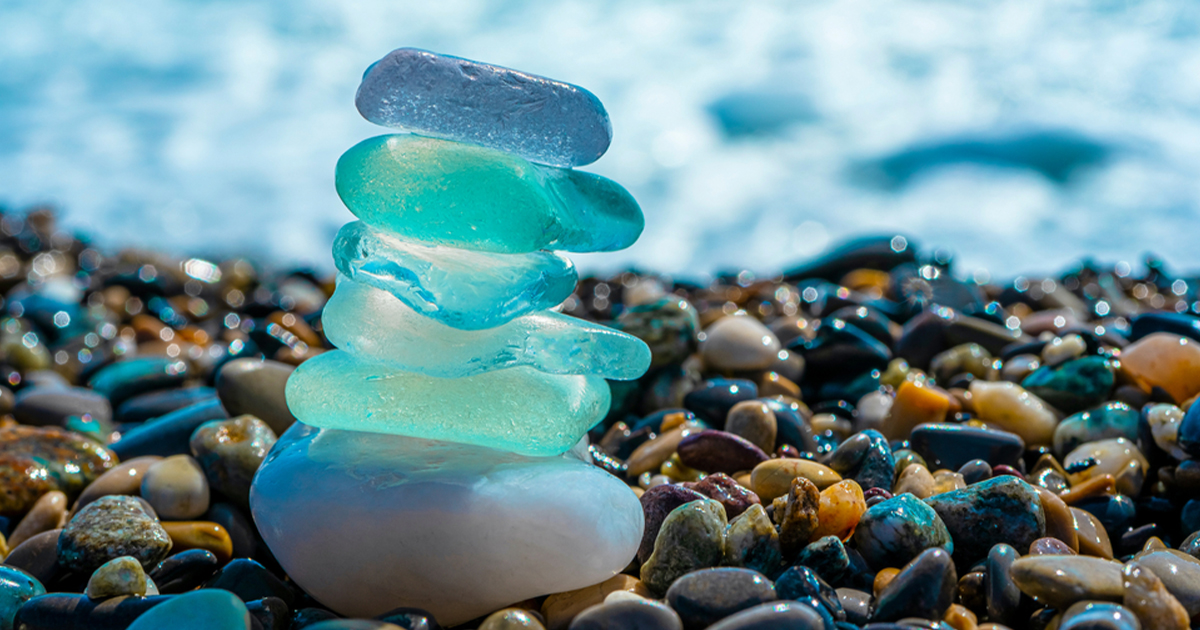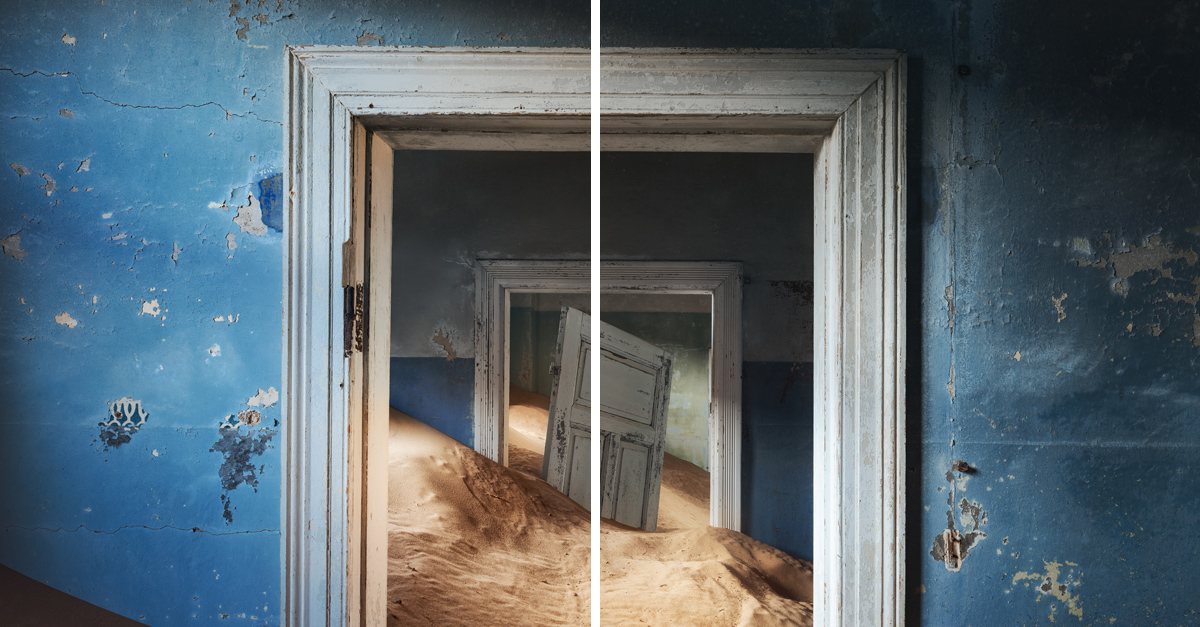The Natural Recycler
From forgotten dumping grounds to stunning landmarks, Glass Beaches have become must-see destinations, drawing in thousands of visitors each year.
But what is it about these unique beaches that captivate so many?

What are glass beaches?
Glass Beaches are beautiful ocean shorelines where the sand is mixed with an abundance of colorful glass pebbles.
How are glass beaches formed?
Glass Beaches are formed when discarded glass bottles, jars, and other glass objects end up in the ocean.
Over time, the glass fragments are shaped and polished by the waves, tumbling against the rocks and sand.
 Revital Salomon, CC BY-SA 4.0, Wikimedia Commons
Revital Salomon, CC BY-SA 4.0, Wikimedia Commons
Where does the glass come from?
The glass found on glass beaches typically comes from old beachside garbage dumps or nearby communities that once discarded their waste into the ocean.
 Rhododendrites, CC BY-SA 4.0, Wikimedia Commons
Rhododendrites, CC BY-SA 4.0, Wikimedia Commons
How long does it take to soften the glass?
The sharp shards of glass are tumbled through the waves, softening them slowly. It takes around 20-40 years to gradually smooth and shape the glass fragments into small colorful pebbles.
Some sea glass takes 100-200 years to acquire its characteristic texture and shape.
What are the pebbles called?
The small colorful pebbles created from the glass are referred to as “sea glass” pebbles.
What colors are the pebbles?
The sea glass pebbles are typically shades of blue, green, brown, white, and occasionally red and orange. It all depends on the colors of the glass bottles that were discarded.
 Chris H. Galbraith, Shutterstock
Chris H. Galbraith, Shutterstock
Can you walk on a glass beach?
Yes, it is safe to walk along a glass beach. The sea glass has been softened enough that it will not likely hurt your feet.
Can you take the glass pebbles home?
While it’s encouraged to leave the beach as you found it, glass beaches, despite their origins in discarded waste, possess a unique natural beauty that draws thousands of visitors each year.
Some people prefer to clean up the beaches, while others believe it’s important to leave the glass behind for future generations to experience.
Is sea glass bad for the environment?
Considering sea glass is technically discarded trash dumped in the ocean, yes, it is bad for the environment. Many times there is much more than clean glass being tossed into the water.
What are the advantages of sea glass?
Since glass in particular is a natural recycled material, it can then be used in place of new, raw materials in a variety of ways.
What is sea glass used for?
Sea glass is commonly used to create jewelry, and various art pieces. Genuine sea glass can be a valuable commodity if it comes from an actual glass beach.
 seeshooteatrepeat, Shutterstock
seeshooteatrepeat, Shutterstock
How do you know if sea glass is genuine?
You can spot real sea glass from fake sea glass by looking for the distinct “pitted” appearance. Some natural sea glass also has a frosty look to it, from the salt content in the ocean.
What do the colors mean?
The color of the sea glass pebbles reveals the type of bottle they originated from. Green glass typically comes from beer, wine, or soda bottles, while brown glass is mostly from beer bottles and older household cleaners. White sea glass usually comes from soda bottles or window panes.
How are the colors classified?
Sea glass colors are classified by rarity. There are seven ultra-rare colors and five rare colors. Then there are about five other colors that are more commonly found.
What is the rarest color of sea glass?
Orange is the rarest sea glass color mainly because there was very little orange glass made. The other “ultra-rare” colors include turquoise, red, yellow, black, teal and grey.
What are the rare colors?
After the ultra-rare colors, the next most rare colors of sea glass include pink, aqua, cobalt, cornflower blue, and purple (amethyst).
Which colors are most commonly found?
The most common colors of sea glass found are amber, UV green, sea foam green, white and brown.
What is the most interesting kind of sea glass?
Sea glass made with uranium dioxide will glow under a black light. These may be tough to find, and are considered rare.
Where does glow-in-the-dark sea glass come from?
Ultraviolet glass, a yellow-green hue, was primarily used for household items like tableware from the mid-1800s until WWII. Its rarity today is a reflection of its limited production during that time.
 ShorelineGalesPhotography, Shutterstock
ShorelineGalesPhotography, Shutterstock
What is milk sea glass?
Milk sea glass pebbles are made from a rare kind of opaque white glassware.
What is the spiritual meaning of sea glass?
Some people believe sea glass is regarded as a symbol of renewal and healing—a metaphor for life.
What is pirate sea glass?
"Pirate Sea Glass" refers to small glass pebbles that appear black at first glance, but reveal their true dark olive-green color when held up to the light.
Many of these pieces contain air bubbles, a sign they were handmade and likely quite old.
Is sea glass only found on ocean shorelines?
No, sea glass can also be found on fresh-water beaches from large lakes. Any body of water that has a high amount of garbage in it, either from shipwrecks or from dump sites.
Which North American Lake has the most beach glass?
Lake Eerie, which borders Michigan, Ohio, Pennsylvania, New York, and the Canadian province of Ontario, is said to be a goldmine for beach glass.
Its 2,000+ shipwrecks, combined with shallow waters and Cleveland’s multiple dump sites make it a prime location for beach glass.
 Jeffrey M. Frank, Shutterstock
Jeffrey M. Frank, Shutterstock
What is the largest piece of beach glass ever found?
Largest piece of beach glass ever found on Lake Erie weighing in at 275 pounds. It is currently being displayed at the Ashtabula Maritime & Surface Transportation Museum near Cleveland, Ohio.
Can sea glass be found on any coastal beach?
While you might occasionally spot a piece of sea glass on ocean shorelines, glass beaches are typically formed closer to old garbage dump sites.
There are a few famous glass beaches around the world, with one in the U.S. being a particularly popular tourist destination.
Where are the glass beaches located?
There are several glass beaches around the world. Some in particular are located in England, Puerto Rico, Australia, Bermuda, Hawaii, Spain, Japan, the USA, and more.
Which glass beach is the most well-known?
The most famous Glass Beach is located in MacKerricher State Park near Fort Bragg, California. It was formerly a dumping ground for trash in the early to mid-20th century.
 Jef Poskanzer, CC BY 2.0, Wikimedia Commons
Jef Poskanzer, CC BY 2.0, Wikimedia Commons
How did the beach in Fort Bragg become a glass beach?
Back in 1906, Fort Bragg residents established an official water dumping site close by, where they disposed of glass bottles, appliances, and even vehicles.
In 1946, once that site was filled up, they opened a second site, and then a third. The third site is now what is known as The Glass Beach.
 Jef Poskanzer, CC BY 2.0, Wikimedia Commons
Jef Poskanzer, CC BY 2.0, Wikimedia Commons
Is it still a dump site today?
No, the California State Water Resources Control Board and city leaders closed the dumping site in 1967.
Were there any clean-up efforts?
Yes—over the years, various cleanup efforts were launched to reverse the damage. As time passed, biodegradable materials naturally broke down, and metals were collected and sold for scrap.
In the end, all that remained was the glass.
 Jef Poskanzer, CC BY 2.0, Wikimedia Commons
Jef Poskanzer, CC BY 2.0, Wikimedia Commons
Why were the glass pieces left behind?
It is likely that the glass was left behind simply because it was too small to gather. Over the years, the glass had already broken into small pieces, softened, and scattered around the ocean floor.
 dave ungar, CC BY-SA 2.0, Wikimedia Commons
dave ungar, CC BY-SA 2.0, Wikimedia Commons
How many glass beach sites are in Fort Bragg?
There are actually three glass beaches in the Fort Bragg area of California. These coordinate with the three dump sites listed earlier.
Where exactly are they located?
Sites Two and Three (the third one being officially known as “Glass Beach”) are located at the end of the path that begins on the corner of Elm Street and Glass Beach Drive.
These sites are accessible by foot and by a short climb down the cliffs surrounding the beach.
 Charles Nadeau, CC BY 2.0, Wikimedia Commons
Charles Nadeau, CC BY 2.0, Wikimedia Commons
How many people visit Glass Beach?
Fort Bragg’s glass beaches draw about 1,000 to 1,200 visitors each day during the summer months. The beach is also a favorite in spring and fall—often considered the most beautiful times of year to visit.
How does tourism affect the Glass Beach?
Most visitors collect glass from the glass beaches. Because of this and also because of natural factors (wave action is constantly grinding down the glass), the glass is slowly diminishing.
Eventually, there won’t be any glass left on the glass beaches.
 Robert Couse-Baker, CC BY 2.0, Wikimedia Commons
Robert Couse-Baker, CC BY 2.0, Wikimedia Commons
How can we avoid this?
There is currently a movement by Captain J. H. Forrington to replenish the beaches with discarded glass, allowing nature to continue to make the beautiful glass pebbles.
Who is Captain Forrington?
Captain Forrington, is the founder, owner and curator of the local Sea Glass Museum.
He is a strong advocate for a full-time research facility studying the benefits to the marine environment of the minerals used to make and clarify the glass.
Will this actually happen?
Dumping glass back into the ocean to recreate the glass beaches is highly unlikely.
In 2012, the City Council of the City of Fort Bragg declined to move forward with replenishment efforts due to the cost and assumed likelihood that required permits would not be approved.
 Jim Heaphy, CC BY 3.0, Wikimedia Commons
Jim Heaphy, CC BY 3.0, Wikimedia Commons
How many people collect sea glass?
There are countless people around the world who collect items they find on beaches. They are known as “beachcombers”.
Beachcombers collect sea glass for many reasons: to sell it, to make art with it, and sometimes just to collect it.
How much is sea glass worth?
The value of sea glass can vary widely depending on where it's found, where you're selling it, and the rarity or quality of the pieces. In the U.S., genuine sea glass—especially in rare colors or larger sizes—can sell for anywhere from $5 to $10 per piece.
When is the best time to find sea glass?
After a storm is usually a good time to check the beach for sea glass, as the rough waters bring sea glass from the ocean floor to the shorelines.
Final Thoughts
Though sea glass is essentially ocean-tumbled trash, it offers a fascinating glimpse into the past—revealing how glass is made and the powerful natural forces it endures.
Glass beaches aren’t just visually stunning; they’re also a treasure trove for collectors hoping to find rare pieces and maybe even make a little money, all while soaking in nature’s curious beauty.





































